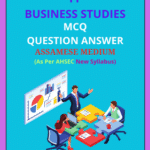Class 11 Business Studies MCQ Chapter 2 Forms of Business Organisation Solutions to each chapter is provided in the list so that you can easily browse through different chapters Class 11 Business Studies MCQ Chapter 2 Forms of Business Organisation Question Answer and select need one. NCERT Class 11 Business Studies MCQ Chapter 2 Forms of Business Organisation Solutions Download PDF. AHSEC Class 11 Business Studies Multiple Choice Solutions.
Class 11 Business Studies MCQ Chapter 2 Forms of Business Organisation
Also, you can read the NCERT book online in these sections Solutions by Expert Teachers as per Central Board of Secondary Education (CBSE) Book guidelines. NCERT Class 11 Business Studies Objective Type Solutions are part of All Subject Solutions. Here we have given AHSEC Class 11 Business Studies Multiple Choice Question and Answer, HS First Year Business Studies MCQ Solutions for All Chapters, You can practice these here.
Forms of Business Organisation
Chapter: 2
| MCQ |
1. What is the main characteristic of a minor in a Joint Hindu family business?
(i) Cannot be a member.
(ii) Can only be a partner.
(iii) Can be a member by birth.
(iv) Must be registered.
Ans: (iii) Can be a member by birth.
2. The structure in which there is separation of ownership and management is called.
(i) Sole proprietorship.
(ii) partnership.
(iii) Company.
(iv) All business Organisations.
And: (iii) company.
3. The Karta in Joint Hindu family business has.
(i) Limited liability.
(ii) Unlimited liability.
(iii) No liability for debts.
(iv) Joint liability.
Ans: (i) Limited liability.
4. In a co-operative society the principle followed is
(i) One share one vote.
(ii) One man one vote.
(iii) No Vote.
(iv) Multiple votes.
Ans: (ii) One man one vote.
5. The board of directors of a joint stock company is elected by.
(i) General public.
(ii) Government bodies.
(iii) Shareholders.
(iv) Employees.
Ans: (iii) Shareholders.
6. The maximum number of partners allowed in the banking business are.
(i) Twenty.
(ii) Ten.
(iii) No limit.
(iv) Two.
Ans: (ii) Ten.
7. Profits do not have to be shared this statement refers to.
(i) Partnership.
(ii) Joint Hindu family business.
(iii) Sole proprietorship.
(iv) Company.
Ans: (iii) Sole proprietorship.
8. The capital of a company is divided into a number of parts each one of which is called.
(i) Dividend.
(ii) Profit.
(iii) Interest.
(iv) Share.
Ans: (iv) Share.
9. The Head of the Joint Hindu family business is called.
(i) Proprietor.
(ii) Director.
(iii) Karta.
(iv) Manager.
Ans: (iii) Karta.
10. Provision of residential accommodation to the members at reasonable rates is the objective of.
(i) Producers Co-operative.
(ii) Consumers Co-operative.
(iii) Housing Co-operative.
(iv) Credit Co-operative.
Ans: (iii) Housing Co-operative.
11. A partner whose association with the firm is unknown to the general public is called.
(i) Active partner.
(ii) Sleeping partner.
(iii) Nominal partner.
(iv) Secret partner.
Ans: (iv) Secret partner.
12. The _______ of a firm has unlimited liability.
(i) Karta.
(ii) Members.
(iii) Joint Hindu Family.
(iv) Partners.
Ans: (iv) Partners.
13. Indian partnership Act, ______?
(i) 1931
(ii) 1933
(iii) 1932
(iv) 1921
Ans: (iii) 1932
14. The Joint Hindu Family business does not require any agreement as membership is by birth, It is governed by the Hindu succession Act……….
(i) 1955
(ii) 1932
(iii) 1956
(iv) 1951
Ans: (iii) 1956
15. If a sole proprietorship has total assets of ₹1,80,000 and total liabilities of ₹50,000, what is the owner’s equity?
(i) ₹1,80,000
(ii) ₹50,000
(iii) ₹1,30,000
(iv) ₹2,30,000
Ans: (iii) ₹1,30,000

Hi! my Name is Parimal Roy. I have completed my Bachelor’s degree in Philosophy (B.A.) from Silapathar General College. Currently, I am working as an HR Manager at Dev Library. It is a website that provides study materials for students from Class 3 to 12, including SCERT and NCERT notes. It also offers resources for BA, B.Com, B.Sc, and Computer Science, along with postgraduate notes. Besides study materials, the website has novels, eBooks, health and finance articles, biographies, quotes, and more.






